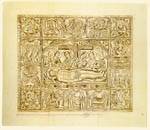|
|
| Antimensia |
1842 Simonopetra Monastery. Sacristy Engraver: Ignatios, hieromonk Engraving printed on cloth, 55 x 64.5 cm Mount Athos. Karyes |
|

|
This antimension was printed from the bronzeplate described above onto a cotton cloth with a thin layer of preparation. The familiar central theme of the Lamentation is framed by the figures of the four Evangelists and a series of ten small square icons depicting liturgical and festal subjects of a manifestly symbolic nature. A characteristic feature of this antimension is that both its composition and figures parallel the Hagioritic prototypes of the folk portable icons of the period. The engraving and printing workshops on Mount Athos began from the time they were established to create their own style, in which Western influence was minimised and a naive style, austere and somewhat rigid, prevailed: this is evident in the present specimen. This style crystallised in the first quarter of the nineteenth century with the creation of the so-called 'Hagioritic type' of antimension (1826), which was copied thereafter by various Athonite engravers, including the hieromonk Ignatios (an example of whose work we see here), and which, both in the arrangement of the individual themes and in the style, remained unchanged for several decades. This antimension by Ignatios and the other works of this type, while still representative of the narrative style, constitute a special group within the third period, because by their simplicity and austerity of line they preserve and underline the transcendental nature of the icon. The antimension bears the formal inscription of consecration on three sides: 'A divine and sacred altar for the performance of the holy sacrament throughout the dominions of Our Lord Jesus Christ, consecrated and sanctified by the grace of the Holy and Life-Giving Spirit'. On the lower edge we read '+Ο ΠΑΡΟΝ ΕΠΙΤΑΦΙΟΣ ΕΧΑΡΑΧΘΗ ΔΙΑ ΣΙΝΔΡΟΜΗΣ Κ(ΑΙ) ΔΑΠΑΝΗΣ ΒΕΝΙΑΜΗΝ ΜΟΝΑΧΟΥ, ΧΕΙΡ ΔΕ ΙΓΝΑΤΙΟΥ ΙΕΡΟΜΟΝΑΧΟΥ ΑΩΜΒ(, ΕΙΣ ΑΓΙΟΝ ΟΡΟΣ Κ(Α)Ρ(ΥΑΙ)Σ' (This epitaphios was engraved with the help and through the generosity of Veniamin, monk, by the hand of hieromonk Ignatios, 1842, at Karyes on the Holy Mountain). The lower border also carries the record of its consecration, printed in blue ink: '+ Eγκαινιάσθη το παρόν εν τη εν Kαρύαις Eκκλησία αγίου Iγνατίου, κέλλα της Iεράς Mονής Xειλανταρίου παρ' εμού του ταπεινού. O Ξάνθης Iλαρίων την 20 (ο)κ(τω)βρίου 1872' (This antimension was dedicated in Karyes, in the Church of Hagios Ignatios, a kellion of the Holy Monastery of Chelandari, by my humble self (signed) Hilarion of Xanthi, October 20, 1872). Hilarion of Lefki served in the Bishopric of Xanthi from 1867 to 1872, when he was translated to the Bishopric of Samakov. The Kellion of Hagios Ignatios, a dependency of the Monastery of Chelandari, is in Karyes, adjacent to its present-day Delegation.
| |
|
Bibliography: Theochari 1971, no. 12. Papastratou 1986, no. 591. Neilos 1991, pp. 249-50.
| ||
| H.N.S. | ||
| Index of exhibits of Monastery of Simonopetra 19th century |
||
Reference address : https://www.elpenor.org/athos/en/e218cl9.asp